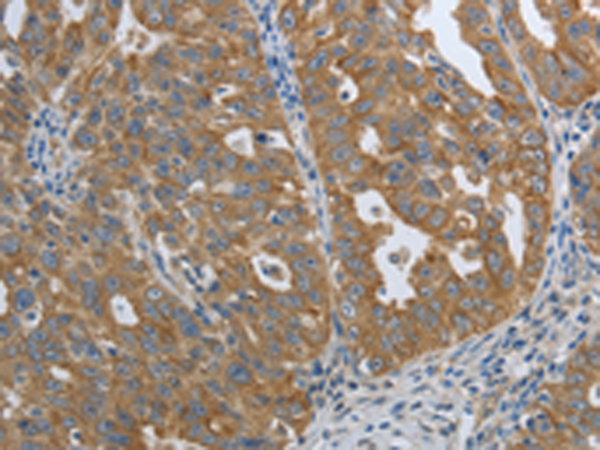

| WB | 咨询技术 | Human,Mouse,Rat |
| IF | 咨询技术 | Human,Mouse,Rat |
| IHC | 1/100-1/300 | Human,Mouse,Rat |
| ICC | 技术咨询 | Human,Mouse,Rat |
| FCM | 咨询技术 | Human,Mouse,Rat |
| Elisa | 1/2000-1/10000 | Human,Mouse,Rat |
| Aliases | RPTPM, RPTPU, PTPRL1, hR-PTPu, R-PTP-MU |
| Host/Isotype | Rabbit IgG |
| Antibody Type | Primary antibody |
| Storage | Store at 4°C short term. Aliquot and store at -20°C long term. Avoid freeze/thaw cycles. |
| Species Reactivity | Human, Mouse |
| Immunogen | Synthetic peptide of human PTPRM |
| Formulation | Purified antibody in PBS with 0.05% sodium azide and 50% glycerol. |
+ +
以下是关于PTPRM抗体的3篇参考文献示例(内容为模拟概括,具体文献请通过学术数据库检索确认):
---
1. **文献名称**: *PTPRM regulates cell-cell adhesion through tyrosine dephosphorylation of β-catenin*
**作者**: Aicher B, et al.
**摘要**: 研究利用PTPRM特异性抗体证实,PTPRM通过去磷酸化β-catenin调控细胞间黏附连接,影响上皮细胞屏障功能,为肿瘤转移机制提供新见解。
---
2. **文献名称**: *Role of PTPRM in neural development and synaptic plasticity*
**作者**: Han KS, et al.
**摘要**: 通过免疫组化和Western blot分析,发现PTPRM抗体标记的蛋白在神经元突触中高表达,其缺失导致突触可塑性异常,提示其在神经发育中的关键作用。
---
3. **文献名称**: *PTPRM interacts with receptor tyrosine kinases in cancer progression*
**作者**: Müller S, et al.
**摘要**: 使用PTPRM抗体进行共免疫沉淀实验,发现其与EGFR等受体酪氨酸激酶相互作用,抑制下游信号通路,可能作为癌症治疗的潜在靶点。
---
如需具体文献,建议通过PubMed或Google Scholar搜索关键词“PTPRM antibody”或“PTPRM function”获取最新研究。
The protein tyrosine phosphatase receptor type M (PTPRM) is a member of the receptor-type PTP family, which plays critical roles in regulating cellular signaling by dephosphorylating tyrosine residues. PTPRM is characterized by a unique extracellular domain containing fibronectin type III-like repeats and a single intracellular catalytic phosphatase domain. It is involved in homophilic cell-cell adhesion and modulates intracellular signaling pathways that control cell growth, differentiation, and migration. Dysregulation of PTPRM has been implicated in various diseases, including cancer, neurological disorders, and autoimmune conditions, highlighting its importance in maintaining cellular homeostasis.
Antibodies targeting PTPRM are essential tools for investigating its expression, localization, and functional mechanisms. These antibodies enable the detection of PTPRM in tissues or cell lines via techniques like Western blotting, immunohistochemistry, and flow cytometry. They also facilitate studies on PTPRM's role in signal transduction, particularly its interactions with adhesion molecules (e.g., cadherins) and growth factor receptors. Recent research has explored PTPRM's dual role as both a tumor suppressor and promoter, depending on cellular context, making its antibodies valuable for cancer biomarker studies. Additionally, PTPRM antibodies contribute to understanding synaptic plasticity and neural development, as the protein is enriched in neuronal tissues. Ongoing efforts focus on developing highly specific monoclonal antibodies to improve diagnostic and therapeutic applications, particularly in targeting PTPRM-related pathways in disease models.
×